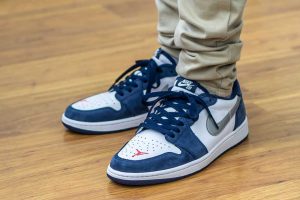The Air Jordan 1 is an enduring style symbol in the sneaker collecting world. But for those considering adding this classic to their collection, the critical question lingers: “Is the Air Jordan 1 true to size?” I’ll attempt to decode the Air Jordan 1’s sizing in this article!
Air Jordan 1 True to Size
Air Jordan 1s fit true to size, generally speaking. Some find the fit to be on the narrow side however. Foot shape and materials are factors as to the overall fit.

The tall, skinny, narrow fit is technically
true to size, but can vary based on your
tolerance for this type of fit
Buy AJ1s: eBay
The materials used in Air Jordan 1 construction significantly impact the fit. The sneakers often feature a combination of leather, suede, and synthetic materials. Softer leather and suede tends to mold to the foot’s shape over time, offering a snug but true fit. Stiffer materials require more break-in time and may never quite adjust to the wearer’s foot shape. So if fit is often an issue with Air Jordan 1s for you, you may want to either go up in size or choose a pair with softer materials.
Additionally, the shape of your feet plays a crucial role in how Air Jordan 1s fit. While they typically fit true to size, they do have a slightly narrow design when compared to other Nikes. If you have narrow or standard-shaped feet, your regular size should work well. However, for those with wider feet, consider going up by half a size to ensure comfort. The extra room can mitigate an otherwise extended break in time.
Should You Size Up or Down for Jordans
Generally speaking, you should stick with your true size for Air Jordans. If the materials are stiffer or you have an exceptionally wide foot, consider going up a half size.

This sneaker is more forgiving on width
than older AJ1s, but not by much
I’ve never seen an Air Jordan 1 High that fit big. Other cuts of AJ1 might fit a bit wider, but the high tops seem to have a notably narrow fit. Jordan 1s with softer suedes and leathers can break in faster, but right out of the box most pairs released these days feel stiffer. At true to size, you might think it feels small.
Assume you will have to break the sneaker in and soften it up a bit through wear. The materials used will affect how long this process will take, however, it results in the truest fit long-term. If you don’t plan on wearing the sneaker a lot, or have a naturally wide foot, going up a half size should help avoid a painful break in. If you don’t want to tough out the break in period, just go up a half size.
Basically, the shoes fit at true to size, but may require more break-in time to feel like they truly have that true fit. This can be bypassed by going up a half size.
Comfort Assessment: Air Jordan 1
Air Jordan 1s are not known for their comfort right out of the box, but can grow in comfort as the shoe breaks in. Still, style makes them an attractive option for those that either collect sneakers, or just like to stay up on the latest trends.

These will give a less claustrophobic fit around
the ankle area.
Step in comfort (or initial comfort when the sneaker is brand new) on the Jordan 1 is not generally present for most. After wearing the sneaker for a while, one can achieve a more comfortable fit.
Once the sneaker is broken in, the comfort on the upper will be a bit more present, however underfoot might still feel rather stiff.
This is because underfoot we have basic Nike Air cushioning, which serves mostly to get the sneaker’s weight down than to add support or comfort. This could be improved by adding insoles, however these can also take up room in an already narrow fitting shoe.
AJ1 highs do provide some ankle support, but it’s a personal choice as to whether you find this comfortable. If the ankle bothers you, opt for a low top pair instead.
Need to translate your size from Mens -> Women’s, UK or JP sizes? Try my new shoe size calculator.
